

Tertiary Education Quality and Standards Agency. First day, first class lessons: What makes them exceptional? - Erica McWilliam - There are any number of ways to kick the year off with a new class.
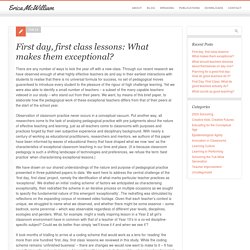
Through our recent research we have observed enough of what highly effective teachers do and say in their earliest interactions with students to realise that there is no universal formula for success, no set of pedagogical moves guaranteed to introduce every student to the pleasure of the rigour of high challenge learning. Yet we were also able to identify a small number of teachers – a subset of the many capable teachers videoed in our study – who stand out from their peers.
We want, by means of this brief paper, to elaborate how the pedagogical work of these exceptional teachers differs from that of their peers at the start of the school year. The seven ways of learning. Putting the pedagogic horse in front of the technology cart – Michael Sankey. Michael Sankey, Learning Futures, Griffith University This article was originally published in Chinese, as a peer reviewed article in the Journal of Distance Education in China.
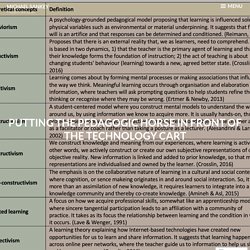
Citation: Sankey, M. (2020). Pedagogy Resources. 5 Teaching Strategies of Award-Winning Online Instructors. The spring of 2020 has brought a sudden shift for many classrooms into an online setting.
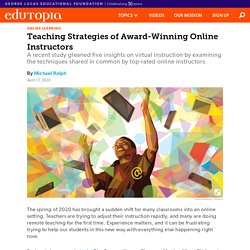
Teachers are trying to adjust their instruction rapidly, and many are doing remote teaching for the first time. Experience matters, and it can be frustrating trying to help our students in this new way with everything else happening right now. Fortunately, a recent study by Swapna Kumar, Florence Martin, Albert Ritzhaupt, and Kiran Budhrani in the open-access journal Online Learning shares the stories of a group of eight award-winning online instructors with a combined 109 years of experience teaching online courses. The study authors interviewed university-level instructors about their approaches to online instruction.
These approaches apply to K–12 students as well, because the instructors emphasize things like relevant course materials, a flexible approach to student work, and the importance of reflection in learning—all things we need in elementary and secondary education, too. ABC Learning Design – Sprint design your courses and programs in just 90 minutes. Five Stage Model - Gilly Salmon. The 7Cs of Learning Design Toolkit. This section contains an integrated set of resources for technology-enhanced learning design across discplines. The resources have all been tried and tested by participants on the University of Leicester's Carpe Diem workshops and the Open University's OULDI (OU Learning Design Initiative) project, and are organised under the headings of seven Cs: conceptualise, capture, create, communicate, collaborate, consider and consolidate.
How to use the 7Cs toolkit for designing technology-enhanced learning A brief guide to using the resources in this toolkit. Students as Partners in Studying Engaged Learning - Center for Engaged Learning. As one of his five principles of good practice in the Scholarship of Teaching and Learning (SoTL), Peter Felten suggests that SoTL should be “conducted in partnership with students” (p. 123).
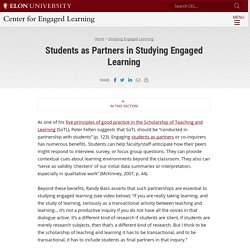
Engaging students as partners or co-inquirers has numerous benefits. Students can help faculty/staff anticipate how their peers might respond to interview, survey, or focus group questions. They can provide contextual cues about learning environments beyond the classroom. They also can “serve as validity ‘checkers’ of our initial data summaries or interpretation, especially in qualitative work” (McKinney, 2007, p. 44). Students as Co-designers. Bottlenecks to Learning. Most instructors notice places in their courses where students find it difficult to learn.

Decoding the Disciplines holds that these stuck places, or “bottlenecks” to learning, mark the important ways of knowing in a field. By “Decoding” what an expert does so that they do not get stuck at the bottleneck, we can spell out the expert’s mental process, the “critical thinking” of a discipline. How To Mitigate The Forgetting Curve With Microlearning. With an increasingly globalized workforce it is important that employees constantly learn to adapt to new roles and obtain new skills.
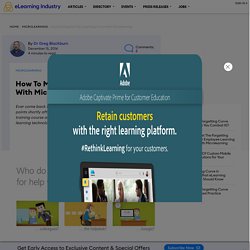
Companies are spending more than ever to keep their workforce up-to-date and remain relevant. Yet, there is a huge misunderstanding between training need and training deployment. Gibbs' Reflective Cycle. One of the most famous cyclical models of reflection leading you through six stages exploring an experience: description, feelings, evaluation, analysis, conclusion and action plan.
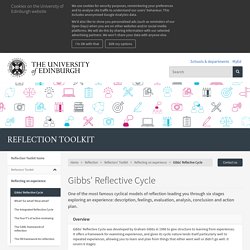
Gibbs' Reflective Cycle was developed by Graham Gibbs in 1988 to give structure to learning from experiences. It offers a framework for examining experiences, and given its cyclic nature lends itself particularly well to repeated experiences, allowing you to learn and plan from things that either went well or didn’t go well.
Community of Practice Design Guide. Blended Learning Toolkit. Introduction The BlendKit Course is a set of subject matter neutral, open educational resources related to blended learning developed by Dr.

Kelvin Thompson and available for self-study or for group use. Periodically, these materials will also be used as the basis for a facilitated open, online course. Active Learning: Activities. Peer Instruction (Mazur) Introduction In today's classrooms, there is great demand for active learning among both students and educators.
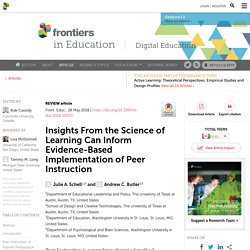
Calls for active learning are not new (see Eliot, 1909), but a recent surge of interest in this concept is transforming pedagogical practices in higher education. The inspiration for this movement comes in large part from the now well-established benefits for student achievement and motivation produced by active learning environments (Bonwell and Eison, 1991; Braxton et al., 2000; National Research Council, 2000; Ambrose et al., 2010; Freeman et al., 2014). With a growing number of educators keenly aware of the limitations of “transmissionist” teaching methods, many of them are trying out new pedagogical methods that encourage active learning (Dancy et al., 2016). Summaries of Learning Theories and Models - Learning Theories.
Education Theory/Constructivism and Social Constructivism. "Constructivism is the philosophical and scientific position that knowledge arises through a process of active construction.
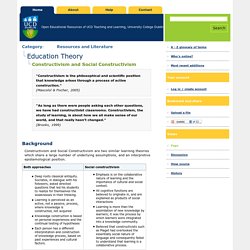
"(Mascolol & Fischer, 2005) "As long as there were people asking each other questions, we have had constructivist classrooms. Constructivism, the study of learning, is about how we all make sense of our world, and that really hasn’t changed. " Zone of Proximal Development and Scaffolding. The Zone of Proximal Development and Scaffolding By Dr. Saul McLeod, updated 2019 What Is the Zone of Proximal Development? The zone of proximal development refers to the difference between what a learner can do without help and what he or she can achieve with guidance and encouragement from a skilled partner. LD Samples.
What is Self-Regulated Learning? As a a first-generation college student and a single mom, Tina strives for a better life for herself and her daughter. She knows that a college education will set her on a path to a rewarding livelihood, but juggling college, work, and family puts many different demands on her time. Tina is dedicated to her studies and she dutifully highlights her textbook readings, memorizes vocabulary words, and spends long hours studying the night before her first exam. And yet, she earns only a mediocre grade. I guess I'm not cut out for college after all, she muses. Challenge-based Learning. Challenge based learning - examples. Student View of Excellent Teaching. Backward Design. Understanding by Design. Overview Understanding by Design is a book written by Grant Wiggins and Jay McTighe that offers a framework for designing courses and content units called “Backward Design.”
Instructors typically approach course design in a “forward design” manner, meaning they consider the learning activities (how to teach the content), develop assessments around their learning activities, then attempt to draw connections to the learning goals of the course. Resources teaching methods backwards design. Instructional Design Articles. OLC Research Center for Digital Learning & Leadership - Teaching & Learning. InstructionalDesign.org. Creating the right "climate" in the course for learning. Instructional Design. Learning Theories & Theorists. Learning Theories. Designing for development of cross-cultural competence in "at home" students and programs (those who cannot partake in Study Abroad)
Ungrading, with Susan Blum. [00:00:00] Bonni Stachowiak: Today on episode number 350 of The Teaching in Higher Ed podcast, Ungrading with Susan Blum. [music] [00:00:09] Production Credit: Produced by Innovate Learning, maximizing human potential. Nudging explained - SUE. Instructional Design Central (IDC) Instructional Design in Higher Education: Defining an Evolving Field. Tech and Learning.